CHAPTER 2 BASIC ELEMENTS OF C In this

CHAPTER 2 BASIC ELEMENTS OF C++

In this chapter, you will: · Become familiar with the basic components of a C++ program, including functions, special symbols, and identifiers · Explore simple data types and examine the string data type · Discover how to use arithmetic operators · Examine how a program evaluates arithmetic expressions · Learn what an assignment statement is and what it does · Discover how to input data into memory using input statements · Become familiar with the use of increment and decrement operators · Examine ways to output results using output statements · Learn how to use preprocessor directives and why they are necessary · Explore how to properly structure a program, including using comments to document a program · Learn how to write a C++ program

· A computer program or a program is a sequence of statements whose objective is to accomplish some task. · Programming is a process of planning and creating a program. · Cooking Recipe · It is usually easier to follow a recipe than to create one. · There are good recipes and there are bad recipes. · There are recipes which are easy to follow and there are those which are not. · There are recipes whose end results are reliable and there are those that are not. · One must have some knowledge of how to use cooking tools to follow a recipe to completion. · The same is true about programming

The Basics of a C++ Program · A C++ program is a collection of one or more subprograms, called functions. · Roughly speaking, a subprogram or a function (like a program) is a collection of statements and when it is activated (that is, executed) it accomplishes something. · Every C++ program has a function called main.

Example 2 -1 #include <iostream> using namespace std; int main() { cout<<"Welcome to C++ Programming"<<endl; return 0; } Output: Welcome to C++ Programming

· To write meaningful programs, we learn the special symbols, words, and the syntax rules of the programming language. · The syntax rules tell us which statements (instructions) are legal, that is, accepted by the programming language and which are not. · Programming Language: A set of rules, symbols, and special words. · Semantic- The semantic rules determine the meaning of the instructions. · Metalanguage- A language used to write the syntax rules.

Syntax template of the function main is: int main() { statement 1. . . statementn return 0; } • In these slides, reddish color indicate a part of the syntax that may or may not appear.

· The smallest individual unit of a program written in any language is called a token. Special-Symbols · The following are some of the special symbols +. <= ; != * ? == / , >= Word-symbols int, float, double, char, void, return · These are called reserved words, or keywords.

Identifier: A C++ identifier consists of letters, digits, and the under score character (_), and must begin with a letter or underscore. · C++ is case sensitive—uppercase and lower case letters are different. · Some of the predefined identifiers are cout and cin. · Unlike reserved words, pre-defined identifiers may be redefined, but it would not be wise to do so.

Example 2 -2 The following are legal identifiers in C++. first conversion pay. Rate counter 1

Data Types and Arithmetic Operators Data Type: A set of values together with a set of operations is called a data type. C++ data types fall into three categories • Simple Data Type. • Structured Data Type. • Pointers.

Simple Data Type C++ simple data can be classified into three categories 1. Integral, which is a data type that deals with integers, or numbers without a decimal part. 2. Floating-point, which is a data type that deals with decimal numbers. 3. Enumeration type, which is a user-defined data type.

Integral data types


int Data Type -6728, -67, 0, 78, 36782, +763, . . . • Positive integers do not have to have a + sign in front of them. • No commas are used within an integer. • In C++ commas are reserved for separating items in a list. So 36, 782 would be interpreted as two integers 36 and 782.

The bool Data Type • The data type bool has two values, true and false. The central purpose of this data type is to manipulate logical (Boolean) expressions. We call true and false the logical (Boolean) values. • In C++, bool, true, and false are reserved words.

char Data Type · char is the smallest integral data type. · char data type is used to represent characters, that is letters, digits and special symbols. · Each character is enclosed within single quote marks. Some of the values belonging to char data type are: 'A', 'a', '0', '*', '+', '$', '&' · Blank space is a character and is written ' ', with a space left between the single quotes.

The Most Common Character Sets: · ASCII (American Standard Code for Information Interchange) and EBCIDIC. · The ASCII character set has 128 values. · EBCIDIC has 256 values and is used by IBM.

ASCII Character Set · Each of the 128 values of the ASCII character set represents a different character. · The value 65 represents 'A', and the value 43 represents '+'. · Each character has a pre-defined ordering, which is called a collating sequence, in the set. · The collating sequence is used when you compare characters. · The value representing 'B' is 66, so 'A' is smaller than 'B'. · '+' is smaller than 'A' since 43 is smaller than 65. · · The first 32 characters in the ASCII character set are nonprintable. The 14 th character in the set is the new line character. In C++, the new line character is represented as 'n'. The horizontal tab character is represented in C++ as 't'. · The null character is represented as '�'.

ASCII (American Standard Code for Information Interchange) Ascii 0 1 2 3 4 5 6 7 0 nul soh stx eot enq ack bel 1 lf vt ff cr so si del dc 1 2 dc 4 nak syn etb can em sub esc 3 rs us b ! “ # $ % 4 ( ) * + , . / 5 2 3 4 5 6 7 8 9 6 < = > ? @ A B C 7 F G H I J K L M 8 P Q R S T U V W 9 Z [ ] ^ _ ` a 10 d e f g h i j k 11 n o p q r s t u 12 x y z { | } ~ del 8 bs dc 2 fs & 0 : D N X b l v 9 ht dc 3 gs ‘ 1 ; E O Y c m w

Floating-Point Data Types • Scientific notation 43872918 = 4. 3872918 *10^7. 0000265 = 2. 65 * 10^(-5) five}, 47. 9832 = 4. 7983 * 10^1 {10 to the power of seven}, {10 to the power of minus {10 to the power of one} • To represent real numbers C++ uses scientific notation called floating-point notation.

float: The data type float is used in C++ to represent any real number between -3. 4 E+38 and 3. 4 E+38. The memory allocated for the float data type is 4 bytes. double: The data type double is used in C++ to represent any real number between -1. 7 E+308 and 1. 7 E+308. The memory allocated for the double data type is 8 bytes. · On most newer compilers, the data types double and long double are the same.

· The maximum number of significant digits—that is, the number of decimal places—in float values is 6 or 7. · The maximum number of significant digits in values belonging to the double type is 15. · The maximum number of significant digits is called the precision. · float values are called single precision · double values are called double precision. 2

The string Type · The data type string is a programmer-defined type and is not part of the C++ language. The C++ standard library supplies it. · A string is a sequence of zero or more characters. · Strings in C++ are enclosed in double quote marks. · A string with no characters is called a null or empty string. "William Jacob" “Mickey" "” · "" is the empty string. · Every character in a string has a relative position in the string. · The position of the first character is 0, position of the second character is 1, and so on. · The length of a string is the number of characters in it.

Example 2 -3 String Position of a Character in the Sting "William Jacob" Position of 'W' is 0. Position of the first 'i' is 1. Position of ' ' (the space) is 7. Position of 'J' is 8. Position of 'b' is 12. “Mickey" Position of Position of ‘M' 'i' 'c' 'k' 'e' 'y' is is is 0. 1. 2. 3. 4. 5. Length of the String 13 6

ARITHMETIC OPERATORS AND OPERATOR PRECEDENCE • Arithmetic Operators + * / % addition subtraction multiplication division remainder (mod operator) · The operators +, -, *, and / can be used with both integral and floating point data types, while % is used only for integral data type to find the remainder in ordinary division.

• Arithmetic Expressions 3 + 4 2 + 3 * 5 5. 6 + 6. 2 * 3 x + 2 * 5 + 6 / y x and y are some unknown numbers • 2

• Unary operator: An operator that has only one operand. • Binary Operator: An operator that two operands. In the expression – 5 – has only one operand, which is 5 and so - acts as a unary operator. In the expression +27 + is a unary operator.

Further, in the expressions 3 + 4 23 - 45 both the operators + and – are binary operators. • – and + are both unary as well as binary arithmetic operators. • *, /, and % are binary arithmetic operators.

Example 2 -4 Arithmetic Expression 2 + 5 13 + 89 34 - 20 45 - 90 2 * 7 5/2 Result 7 102 14 -45 14 2 14 / 7 2 Description In the division 5/2, the quotient is 2 and the remainder is 1. Therefore, 5/2 evaluates to the quotient, which is 2.

34 % 5 4 -34 % 5 -4 34 % -5 4 In the division 34/5, the quotient is 6 and the remainder is 4. Therefore, 34%5 evaluates to the remainder, which is 4 In the division -34 / 5, the quotient is -6 and the remainder is -4. Therefore, -34 % 5 evaluates to the remainder, which is -4. In the division 34 / -5, the quotient is – 6 and the remainder is 4. Therefore 34 % -5 evaluates to the remainder, which is 4. )

-34 % -5 -4 4 % 6 4 In the division -34 / -5, the quotient is 6 and the remainder is -4. Therefore, -34 % -5 evaluates to the remainder, which is -4. ) In the division 4/6, the quotient is 0 and the remainder is 4. Now 4 % 6 evaluates to the remainder, which is 4.

Example 2 -5 Expression Result 5. 0 + 3. 5 3. 0 + 9. 4 16. 3 - 5. 2 4. 2 * 2. 5 5. 0/2. 0 8. 5 12. 4 11. 1 10. 50 2. 5

Order of Precedence The precedence rules of arithmetic operators are: *, /, % are at a higher level of precedence than +, - • Operators *, /, and % have the same level of precedence. • Operators + and - have the same level of precedence.

· When operators are all on the same level, they are performed from left to right. · To avoid confusion, the grouping symbol can be used. For example, 3*7 -6+2*5/4+6 means (3 * 7) - 6 + ( ( 2 * 5) / 4 ) + 6 = 21 - 6 + (10 / 4) + 6 (Evaluate *) = 21 – 6 + 2 + 6 (Evaluate /) = 15 + 2 + 6 (Evaluate -) = 17 + 6 (Evaluate first +) = 23 (Evaluate +)

Character Arithmetic · · 8+7 = 15 '8' + '7' = 56 + 55 = 111 '8' + 7 = 56 + 7 = 63 '8' * '7' is undefined in the ASCII character data set.

EXPRESSIONS • If all operands (that is, numbers) in an expression are integers, the expression is called an integral expression. • If all operands in an expression are floating-point numbers, the expression is called a floating-point or decimal expression. • An integral expression yields an integral result; a floating-point expression yields a floating-point result.

Example 2 -7 Some C++ integral expressions: 2 + 3 * 5 3 + x - y / 7 x + 2 * (y - z) + 18 Example 2 -8 Some C++ floating point expressions: 12. 8 * 17. 5 - 34. 50 x * 10. 5 + y - 16. 2

Mixed Expressions • An expression that has operands of different data types is called a mixed expression. • A mixed expression contains both integers and floating-point numbers. Examples of mixed expressions 2 + 3. 5 6 / 4 + 3. 9 5. 4 * 2 – 13. 6 + 18 / 2

Rules to evaluate a mixed expression 1. When evaluating an operator in the mixed expression: a. If the operator has the same types of operands (that is, either both integers or both floating-point numbers), the operator is evaluated according to the type of the operands. b. If the operator has both types of operands (that is, one is an integer and the other is a floating-point number) then during calculation the integer is changed to a floating-point number with the decimal part of zero and the operator is evaluated. The result is a floating-point number. 2. The entire expression is evaluated according to the precedence rules; the multiplication, division, and modulus operators are evaluated before the addition and subtraction operators. Operators having the same level of precedence are evaluated from left to right. Grouping is allowed for clarity.

Example 2 -9 (a) 3 / 2 + 5. 0 = 1 + 5. 0 = 6. 0 (b) 15. 6 / 2 + 5 = 7. 8 + 5 7. 8) = 12. 8 (c) 4 = = (3 / 2 = 1) (1 + 5. 0 = 1. 0 + 5. 0= 6. 0) (15. 6 / 2 = 15. 6 / 2. 0 = (7. 8 + 5. 0 = 12. 8) * 3 + 7 / 5 – 25. 6 12 + 7 / 5 – 25. 6 (4 * 3 = 12) 12 + 1 – 25. 6 (7 / 5 = 1) 13 – 25. 6 (12 + 1 = 13) -12. 6 (13 – 25. 6 = 13. 0 – 25. 6 = - 12. 6)

· Implicit Type Coercion · Cast operator (type conversion or type casting) Syntax Cast operator static_cast<data. Type. Name>(expression) • Expression is evaluated and its value is converted to value of the type specified by the data. Type. Name.

Example 2 -10 static_cast<int>(7. 9) = 7 static_cast<int>(3. 3) = 3 static_cast<double>(25) = 25. 0 static_cast<double>(5+3) = static_cast<double>(8) = 8. 0 static_cast<double>(15)/2 = 15. 0/2. 0 = 7. 5

static_cast<double>(15/2) = static_cast<double>(7) = 7. 0 static_cast<int>(7. 8 + static_cast<double>(15)/2) = static_cast<int>(7. 8 + 7. 5) = static_cast<int>(15. 3) = 15 static_cast<int>(7. 8 + static_cast<double>(15/2) = static_cast<int>(7. 8 + 7. 0) = static_cast<int>(14. 8) = 14

x = 15 y = 23 z = 3. 75 Expression Value static_cast<int>(7. 9 + 6. 7) 14 static_cast<int>(7. 9) + static_cast<int>(6. 7) 13 static_cast<double>(y / x) + z 4. 75 static_cast<double>(y) / x + z 5. 28333

INPUT Storing data in the computer’s memory is a two step process. • Instruct the computer to allocate memory. • Include statements in the program to put data into the allocated memory.

Allocating Memory with Constants and Variables • Named Constant: A memory location whose content is not allowed to change during program execution. • Variable: A memory location whose content may change during program execution.

Named Constant: The syntax to declare a named constant is const data. Type identifier = value; • In C++, const is a reserved word. Example 2 -11 const double conversion = 2. 54; int no. Of. Students = 20; char blank = ' '; double pay. Rate = 15. 75;

Variable The syntax for declaring one variable or multiple variables is data. Type identifier, . . . ; Example 2 -12 double amount. Due; int counter; char ch; int x, y; string name;

1. In C++, all identifiers must be declared before they can be used. If we refer to an identifier without declaring it, the compiler will generate an error message indicating that the identifier is not declared. 2. A data type is called simple if the variable (or named constant) of that type can store only one value at a time. For example, if x is an, say, int variable. Then at a given time only one value can be stored in x.

Putting Data into Variables • In C++ there are two ways that data can be placed into a variable: 1. Using C++’s assignment statement, and 2. Use input (read) statements.

Assignment Statement The assignment statement takes the form variable = expression; • The expression is evaluated and its value is assigned to the variable on the left side. • In C++, = is called the assignment operator.

Examples 2 -13 int I, J; double sale; char first; string str; I = 4; J = 4 * 5 - 11; sale = 0. 02 * 1000; first = 'D'; str = "It is a sunny day. ";

• A C++ statement like I = I + 2; means evaluate whatever is in I, add two to it, and assign the new value to the memory location I. • The sequence of C++ statements I = 6; I = I + 2; and the statement I = 8; both assigns 8 to I. • The statement I = 5; is read 'I becomes 5', or 'I gets 5'. • Each time a new value is assigned to I, the old value is erased.

If the variables I, J, and K have been properly declared, then the sequence of statements I I J K K = = = 12; I + 6; I; J / 2; K / 3; results in 'K becoming 3', that is, in K having the value 3 stored in it.

· To save the value of an expression and use it in a later expression, do the following: 1. Declare a variable of the appropriate data type. For example, if the result of the expression is an integer, declare an int variable. 2. Assign the value of the expression to the variable that was declared using the assignment statement. This action saves the value of the expression into the variable. 3. Wherever the value of the expression is needed, use the variable holding the value.

Example 2 -14 int a, b, c, d; int x, y; • Evaluate the expressions -b+(b 2 -4 ac)and -b-(b 2 -4 ac), and assign the values of these expressions to x and y, respectively. • The expression b 2 -4 ac appears in both expressions • First calculate the value of this expression and save its value in d. • Use the value of d to evaluate the expressions as shown by the following statements: d = b * b – 4 * a * c; x = -b + d; y = -b – d;

Declaration and Initializing Variables · Variables can be initialized when they are declared int first, second; char ch; double x, y; first = 13; second = 10; ch = ' '; x = 12. 6; y = 123. 456; Equivalently, we can write the following C++ statements. int first=13, second=10; char ch=' '; double x=12. 6, y=123. 456;

Input (Read) Statement Syntax of cin together with >>: cin>>variable. . . ; · In C++, >> is called the extraction operator. · Suppose miles is a variable of the type double. · The statement cin>>miles;

· By using more than one variable in cin, more than one value can be read at a time. Suppose feet and inch are variables of the type int. A statement like cin>>feet>>inch; gets two integers (entered at the keyboard) and places them in the memory location feet and inch, respectively.

Variable Initialization · Assignment statement · Read statement int feet; · We can initialize feet to a value 35 either by using the assignment statement feet = 35; or by executing the statement cin>>feet; · C++ does not automatically initialize the variables when they are declared.

Example 2 -15 int one, two; double z; char ch; string name; 1. one = 4; 2. two = 2 * one + 6; 3. z = (one + 1) / 2. 0; 4. ch = 'A'; 5. cin>>two; 6. cin>>z; 7. one = 2 * two + static_cast<int>(z); 8. cin>>name; 9. two = two + 1; 10. cin>>ch; 11. one = one + static_cast<int>(ch); 12. z = one – z;

Suppose the input is 8 16. 3 Goofy D • Before the execution of statement 1 all variables are uninitialized.

1. one = 4; Statement 1 stores 4 into one. So after the execution of statement 1, the values are

2. two = 2 * one + 6; Statement 2 first evaluates the expression 2 * one + 6 (which evaluates to 14) and then stores the value of the expression, that is, 14 into two. After the execution of statement 2, the values are:

3. z = (one + 1) / 2. 0; Statement 3 first evaluates the expression (one + 1)/2. 0 (which evaluates to 2. 5) and then stores the value of the expression into z. After the execution of statement 3, the values are:

4. ch = 'A'; Statement 4 stores the character 'A' into ch. After the execution of statement 4, the values are:

5. cin>>two; Statement 5 reads a number from the keyboard (which is 8) and stores the number 8 into two. After the execution of statement 5, the values are:

6. cin>>z; Statement 6 reads a number from the keyboard (which is 16. 3) and stores the number 16. 3 into z. After the execution of statement 6, the values are: Note that the variable name is still undefined.

7. one = 2 * two + static_cast<int>(z); Statement 7 first evaluates the expression 2 * two + static_cast<int>(z) (which evaluates to 32) and then stores the value of the expression, that is, 32 into one. After the execution of statement 7, the values are:

8. cin>>name; Statement 8 gets the next input from the keyboard (which is Goofy) and stores it into name. After the execution of statement 8, the values are:

9. two = two + 1; Statement 9 first evaluates the expression two + 1 (which evaluates to 9) and stores the value of this expression, that is, 9 into two. After the execution of statement 9, the values are:

10. cin>>ch; Statement 10 reads the next input from the keyboard (which is D) and stores it into ch. After the execution of statement 10, the values are:

11. one = one + static_cast<int>(ch); Statement 11 first evaluates the expression one + static_cast<int>(ch). Here static_cast<int>( 'D') gives the collating sequence of the character D in the character data set, which is 68 (in ASCII)). After the execution of statement 11, the values are:

12. z = one – z; The statement 12 first evaluates the expression one – z (= 100. 0 – 16. 3 = 83. 7) and then stores the value of this expression, that is 83. 7 into z. The value of the variables after the execution of the last statement are:

INCREMENT AND DECREMENT OPERATORS Increment operator - increment the value of a variable by 1 Decrement operator- decrement the value of a variable by 1. Pre Increment: Post Increment: ++variable++ Pre Decrement: Post Decrement: --variable--

++count; or count++; increments the value of count by 1. --count; or count--; decrements the value of count by 1.

1. x = 5; y = ++x; • After the second statement both x and y are 6. 2. x = 5; y = x++; • After the second statement y is 5 and x is 6. Example 2 -16 Suppose a and b are int variables. a = 5; b = 2 + (++a); After the second statement a is 6 and b is 8.

OUTPUT · The syntax of cout together with << is cout<<expression or manipulator. . . ; · In C++, << is called the insertion operator. · expression (that is, expression) is evaluated and its value is printed at the current cursor position on the screen. · manipulator manipulates the output. The simplest manipulator is endl (the last character is the letter el), which causes the cursor to move to the beginning of the next line. · This is called an output statement. Sometimes this is also called a cout statement. · In C++, << is called the stream insertion operator. · Strings and expressions involving only one variable or a single value are evaluated to itself.

Example 2 -17 Statement 1. cout<<29/4; 2. cout<<"Hello there. "; 3. cout<<12; 4. cout<<"4+7"; 5. cout<<4+7; 6. cout<<"A"; Output 7 7. cout<<"4 + 7 = "<<4 + 7; 4 + 7 = 11 8. cout<<2+3*5; 9. cout<<"Hello nthere. "; 17 Hello there. • n is called new line escape sequence. • (back slash) is called the escape character. Hello there. 12 4+7 11 A

The output of the C++ statement cout<<a; is meaningful provided the variable a has been given a value. For example, the sequence of C++ statements, a = 45; cout<<a; will produce an output of 45.

Example 2 -18 int a, b, c, d; a = 65 ; b = 78 ; //Line 1 //Line 2 cout<<29/4<<endl; cout<<3. 0/2<<endl; cout<<"Hello there. n"; cout<<7<<endl; cout<<3+5<<endl; cout<<"3+5"; cout<<endl; cout<<2+3*6<<endl; cout<<"a"<<endl; cout<<a<<endl; cout<<b<<endl; cout<<c<<'n'; cout<<d; cout<<endl; //Line //Line //Line //Line 3 4 5 6 7 8 9 10 11 12 13 14 15 16

7 1. 5 Hello there. 7 8 3+5 20 a 65 78 6749684 4203005 Output of Statement at Line 3 Line 4 Line 5 Line 6 Line 7 Line 8 Line 10 Line 11 Line 12 Line 13 Line 14 Line 15

• The new line character, 'n'. cout<<"Hello there. "; cout<<"My name is Goofy. "; Output Hello there. My name is Goofy. Now consider the following C++ statements. cout<<"Hello there. n"; cout<<"My name is Goofy. "; Output Hello there. My name is Goofy.

• When n is encountered in the string, the cursor is positioned at the beginning of the next line. • n may appear anywhere in the string. The output of the statement cout<<"n"; is equivalent to the output of the statement cout<<endl; which is equivalent to the output of the statement cout<<'n';

The output of the sequence of statements: cout<<"Hello there. n"; cout<<"My name is Goofy. "; is equivalent to the output of the sequence statements: cout<<"Hello there. "<<endl; cout<<"My name is Goofy. ";

Example 2 -19 cout<<"Hello there. n. My name is Goofy. "; or cout<<"Hello there. "; cout<<"n. My name is Goofy. "; or cout<<"Hello there. "; cout<<endl<<"My name is Goofy. "; In each case the output is Hello there. My name is Goofy.

Example 2 -20 The output of the following C++ statement cout<<"Count. . . n. . 1n. . . 2n. . . 3"; or cout<<"Count. . . "<<endl<<". . 1"<<endl <<". . . 2"<<endl<<". . . 3"; is Count. . . . 1. . . 2. . . 3

Example 2 -21 To output the following sentence in one line as part of a message: It is sunny, warm, and not a windy day. Let us go golfing. We can use any of the following statements: cout<<"It is sunny, warm, and not a windy day. "; cout<<"Let us go golfing. "<<endl; or cout<<"It is sunny, warm, and not a windy day. " <<"Let us go golfing. "<<endl;

• The following statement is illegal in C++. cout<<"It is sunny, warm, and not a windy day. Let us go golfing. "<<endl; • The return (or Enter) key on your keyboard cannot be part of the string.

Example 2 -22 · The output of the statement cout<<"The newline escape sequence is \n"<<endl; is The new line escape sequence is n · The output of the statement cout<<"The tab character is represented as '\t'"<<endl; is The tab character is represented as 't' · The output of the statement cout<<"The string "Sunny" contains five charactersn"; is The string "Sunny" contains five characters

Preprocessor Directives · Only a small number of operations are explicitly defined in C++. · Many of the functions and symbols that are necessary to run a C++ program are provided as a collection of libraries. · Every library has a name and is referred as a header file. For example, the descriptions of the functions needed to perform I/O are contained in the header file iostream. · The descriptions of some very useful mathematics functions such as power, absolute, sine, etc. , are contained in the header file cmath. · Preprocessor directives are commands supplied to the preprocessor. · All preprocessor commands begin with #. · There is no semicolon at the end of these commands since these are preprocessor commands not C++ commands.

The general syntax to include a header file (provided by the SDK) in a C++ program is #include <header. File. Name> The preprocessor directive #include <iostream> causes the preprocessor to include the header file iostream in the program.

• In Standard C++, header files have the file extension. h • In Standard C++, the descriptions of the functions needed to perform I/O are contained in the header file iostream. h #include <iostream. h> #include <math. h>


Using cin and cout in a Program and namespace • One way to use cin and cout in a program is to refer them as std: : cin and std: : cout. • Another option is to include the following statement in your program: using namespace std; • The using statement appears after the statement #include <iostream>.

Using the string Data Type in a Program • To use the string data type in a program, your must include the following preprocessor directive: #include <string>

Program Style and Form The Program Part • Every C++ program has a function main. • The basic parts of the function main are: 1. The heading 2. Body of the function The heading part has the following form type. Of. Function main(argument list)

The statement int main(void) means that the function main returns a value of the type int and it has no arguments. The previous statement is equivalent to statement int main() · It is not necessary to put word the void in parentheses, but the parentheses are still needed.

• The body of the function is enclosed between { and } and has two types of statements. • Declaration statements. • Executable statements.

Declaration Statements int a, b, c; double x, y; · Variables (or identifies) can be declared anywhere in the program, but they must be declared before they can be used. Executable Statements Example 2 -24 Executable statements: a = 4; //assignment statement cin>>b; //input statement cout<<a<<endl<<b<<endl; //output statement

Syntax • Errors in syntax are detected during compilation. int x; int y double z; //Line 1 //Line 2; syntax error //Line 3 y = w + x; //Line 4 ; syntax error

Use of Blanks · In C++, one or more blanks are used to separate numbers when data is input. · Blanks are also used to separate reserved words and identifiers from each other and other symbols. · Commas are used to separate items in a list. Use of Semicolons, Brackets, and Commas · All C++ statements terminate with a semicolon. · The semicolon is also called a statement terminator. · { and } are not C++ statements.

Semantics It is quite possible for you to eradicate all syntax errors in a program and still not have it run. And if it runs it still may not do what you meant it to do. For example, 2 + 3 * 5 and (2 + 3) * 5 are both syntactically correct expressions, but have different meanings.

Form and Style Consider the following two ways of declaring variables. int feet, inch; double x, y; or int a, b; double x, y;

Blank spaces int a, b, c; int a, b, c; The blanks between the identifiers in the second statement are meaningless. In the statement, inta, b, c; no blank between the t and a changes the reserved word int and the identifier a into a new identifier inta.

Documentation Comments • Single line comments begin with // anywhere in the line. • Multiple line comments are enclosed between /* and */.

Naming Identifiers const double a = 2. 54; //conversion constant double x; //variable to hold centimeters double y; //variable to hold inches x = y * a; Consider the following const double conversion = 2. 54; double centimeters; double inches; centimeters = inches * conversion; · Run-together-word inchperfoot • Run-together-words can be handled either by using CAPS for the beginning of each new word or underscore just before the new word. • We could use either inch. Per. Foot or inch_per_foot.

Prompt Lines cout<<"Please enter a number between 1 and 10 and" <<" press the return key"<<endl; cin>>num; When these two statements execute in the order given, first the cout statement causes the following line of text to appear on the screen: Please enter a number between 1 and 10 and press the return key After seeing this line, users know that they must enter a number and press the return key.

MORE ON ASSIGNMENT STATEMENTS Assignment Statements • Simple assignment statements. • Compound assignment statements.

Compound assignment operator op= where op is any of the arithmetic operators. • Using the compound assignment operator, the simple assignment statement variable = variable op (expression); can be rewritten as variable op= expression; and is called the compound assignment statement.

Example 2 -25 Simple Assignment Statement I = I + 5; counter = counter + 1; sum = sum + number; Compound Assignment Statement I += 5; counter += 1; sum += number; amount=amount*(interest+1); amount *= interest + 1; x = x / ( y + 5); x /= y + 5;

PROGRAMMING EXAMPLE: CONVERT LENGTH Write a program that takes as input a given length expressed in feet and inches. It then converts and outputs the length in centimeters. Input: Length in feet and inches. Output: Equivalent length in centimeters.

Problem Analysis and Algorithm Design The lengths are given in feet and inches, and you need to find the equivalent length in centimeters. One inch is equal to 2. 54 centimeters. The first thing the program needs to do is convert the length given in feet and inches to all inches. Then you can use the conversion formula, 1 inch = 2. 54 centimeters, to find the equivalent length in centimeters. To convert the length from feet and inches to inches, you multiply the number of feet by 12, as 1 foot is equal to 12 inches, and add the given inches. For example, suppose input is 5 feet and 7 inches. Then total inches are given by total. Inches = 12 * feet + inches = 12 * 5 + 7 = 67

We now apply the conversion formula, that is, 1 inch = 2. 54 centimeters to find the length in centimeters = total. Inches * 2. 54 = 67 * 2. 54 = 170. 18 The above discussion translates into the following algorithm: 1. Get the length in feet and inches. 2. Convert the length into total inches. 3. Convert total inches into centimeters. 4. Output centimeters.

Variables int feet; //variable to hold given feet inchs; //variable to hold given inches int total. Inches; //variable to hold total inches double centimeters; // variable to hold length //in centimeters. Named Constant const double conversion = 2. 54; const inches. Per. Foot = 12;

Main Algorithm 1. Prompt the user for the input. (Without a prompt line, the user will be staring at a blank screen and will not know what to do. ) 2. Get the data. 3. Echo the input—that is, output what the program read as input. (Without this step, after the program has executed, you will not know what the input was. ) 4. Find the length in inches. 5. Output the length in inches. 6. Convert the length to centimeters. 7. Output the length in centimeters.

Putting it Together • The program will begin with comments that document its purpose and functionality. • There is both input to this program (the length in feet and inches) and output (the equivalent length in centimeters), you will be using system resources for input/output. • The program will use input statements to get data into the program and output statements to print the results. • The data will be entered from the keyboard and the output will be displayed on the screen, the program must include the header file iostream. • The first statement of the program, after the comments as described above, will be the preprocessor directive to include this header file.

• This program requires two types of memory locations for data manipulation: named constants and variables. • Named constants are usually placed before the function main so that they can be used throughout the program. • This program has only one function, the function main, which will contain all of the programming instructions in its body. • The program needs variables to manipulate data, and these variables will be declared in the body of the function main. • The body of the function main has the following form: int main () { declare variables statements return 0; }

In order to write the complete C++ program: 1. Begin the program with comments for documentation. 2. Include header files, if any are used in the program. 3. Declare named constants, if any. 4. Write the definition of the function main.
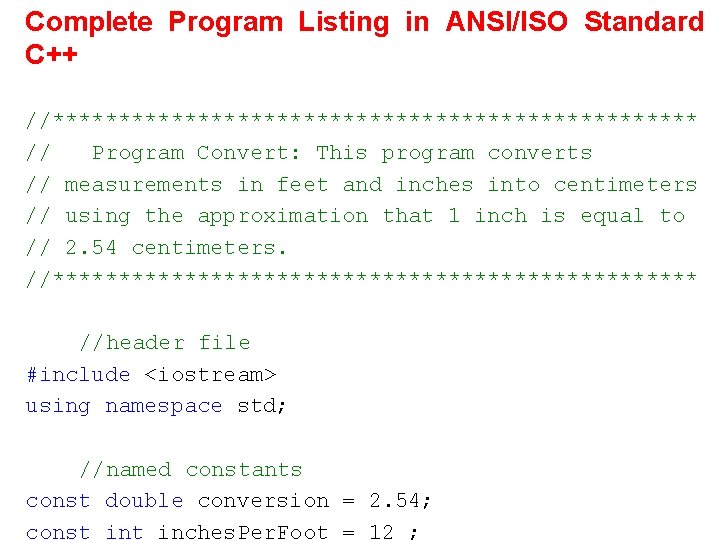
Complete Program Listing in ANSI/ISO Standard C++ //************************* // Program Convert: This program converts // measurements in feet and inches into centimeters // using the approximation that 1 inch is equal to // 2. 54 centimeters. //************************* //header file #include <iostream> using namespace std; //named constants const double conversion = 2. 54; const inches. Per. Foot = 12 ;
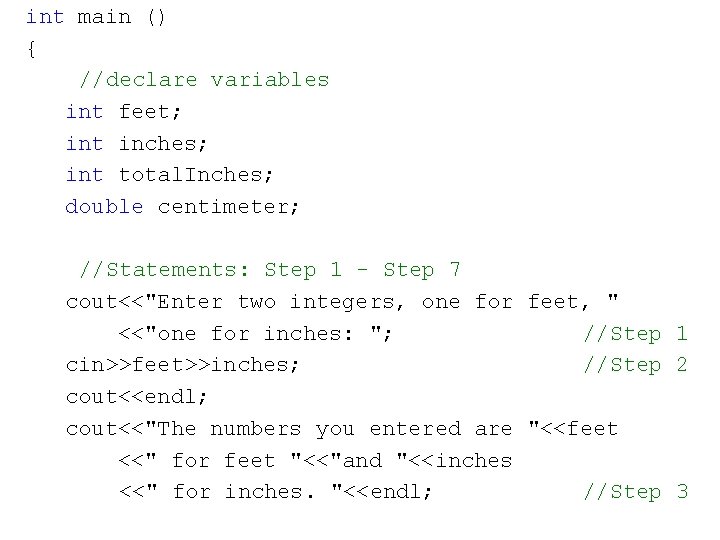
int main () { //declare variables int feet; int inches; int total. Inches; double centimeter; //Statements: Step 1 - Step 7 cout<<"Enter two integers, one for feet, " <<"one for inches: "; //Step 1 cin>>feet>>inches; //Step 2 cout<<endl; cout<<"The numbers you entered are "<<feet <<" for feet "<<"and "<<inches <<" for inches. "<<endl; //Step 3
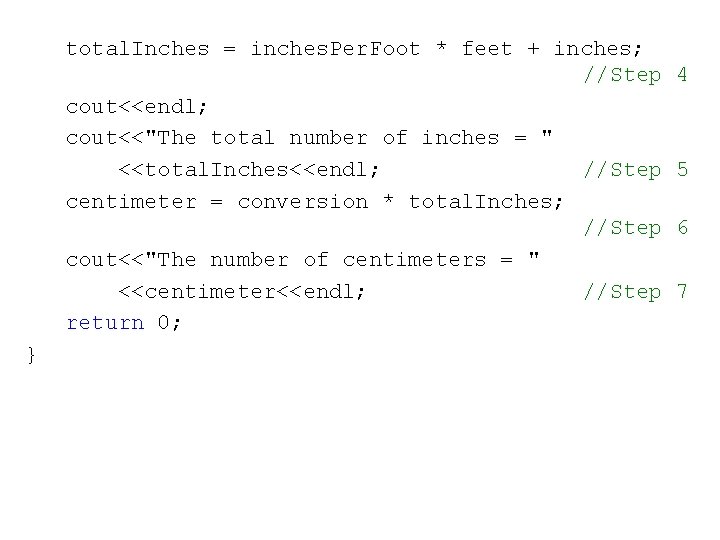
total. Inches = inches. Per. Foot * feet + inches; //Step cout<<endl; cout<<"The total number of inches = " <<total. Inches<<endl; //Step centimeter = conversion * total. Inches; //Step cout<<"The number of centimeters = " <<centimeter<<endl; //Step return 0; } 4 5 6 7
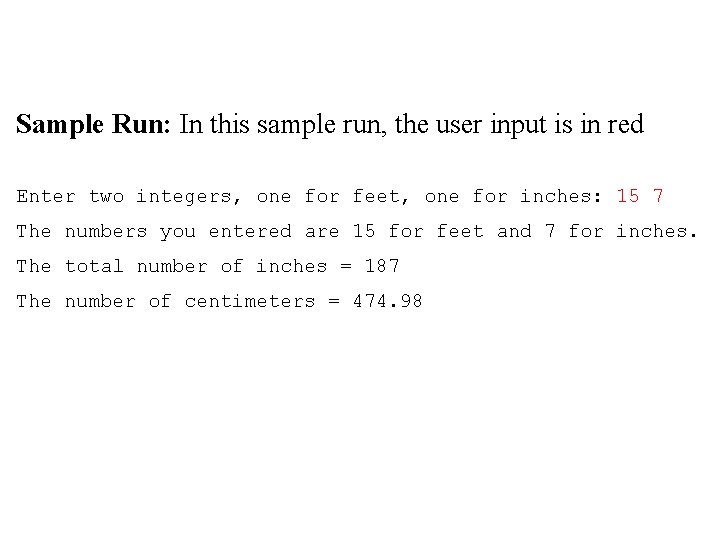
Sample Run: In this sample run, the user input is in red Enter two integers, one for feet, one for inches: 15 7 The numbers you entered are 15 for feet and 7 for inches. The total number of inches = 187 The number of centimeters = 474. 98
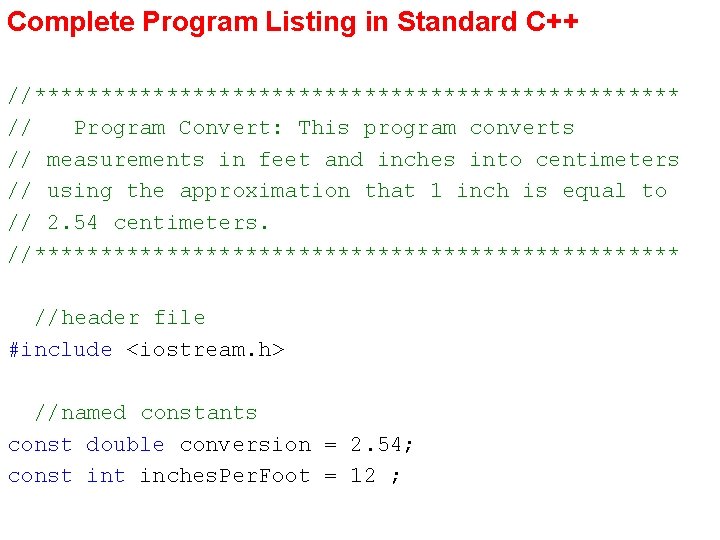
Complete Program Listing in Standard C++ //************************* // Program Convert: This program converts // measurements in feet and inches into centimeters // using the approximation that 1 inch is equal to // 2. 54 centimeters. //************************* //header file #include <iostream. h> //named constants const double conversion = 2. 54; const inches. Per. Foot = 12 ;
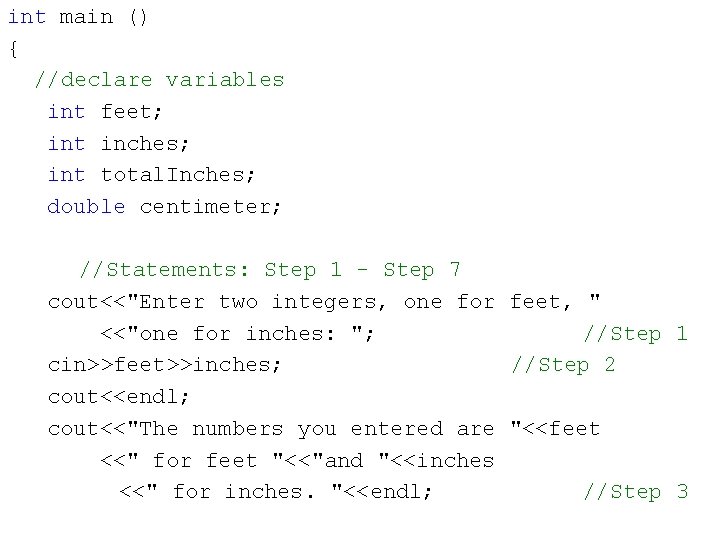
int main () { //declare variables int feet; int inches; int total. Inches; double centimeter; //Statements: Step 1 - Step 7 cout<<"Enter two integers, one for feet, " <<"one for inches: "; //Step 1 cin>>feet>>inches; //Step 2 cout<<endl; cout<<"The numbers you entered are "<<feet <<" for feet "<<"and "<<inches <<" for inches. "<<endl; //Step 3
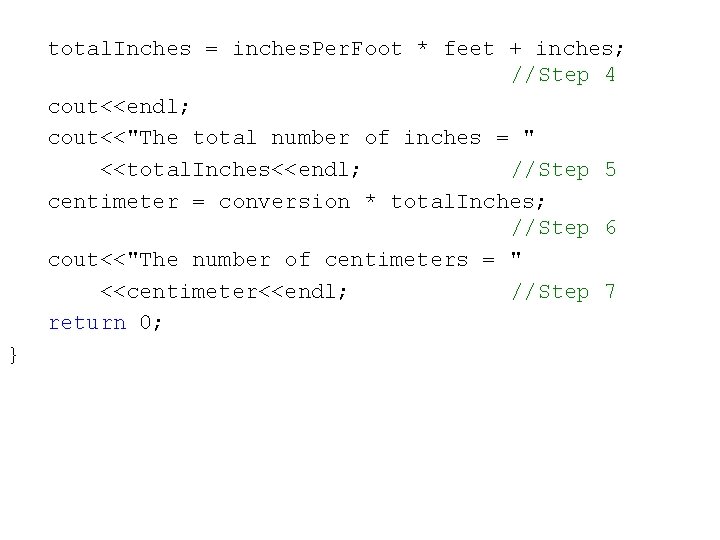
total. Inches = inches. Per. Foot * feet + inches; //Step 4 cout<<endl; cout<<"The total number of inches = " <<total. Inches<<endl; //Step 5 centimeter = conversion * total. Inches; //Step 6 cout<<"The number of centimeters = " <<centimeter<<endl; //Step 7 return 0; }
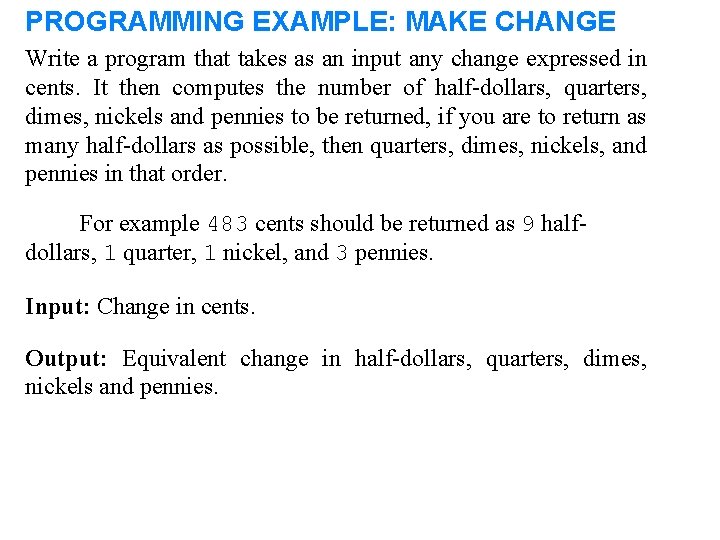
PROGRAMMING EXAMPLE: MAKE CHANGE Write a program that takes as an input any change expressed in cents. It then computes the number of half-dollars, quarters, dimes, nickels and pennies to be returned, if you are to return as many half-dollars as possible, then quarters, dimes, nickels, and pennies in that order. For example 483 cents should be returned as 9 halfdollars, 1 quarter, 1 nickel, and 3 pennies. Input: Change in cents. Output: Equivalent change in half-dollars, quarters, dimes, nickels and pennies.
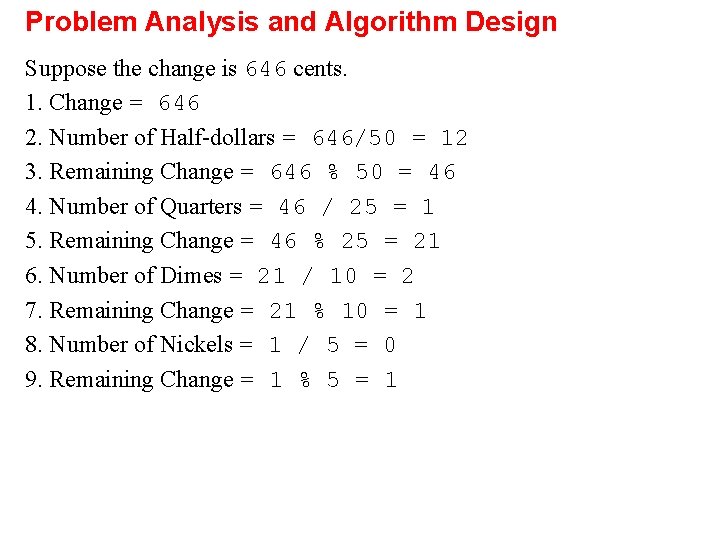
Problem Analysis and Algorithm Design Suppose the change is 646 cents. 1. Change = 646 2. Number of Half-dollars = 646/50 = 12 3. Remaining Change = 646 % 50 = 46 4. Number of Quarters = 46 / 25 = 1 5. Remaining Change = 46 % 25 = 21 6. Number of Dimes = 21 / 10 = 2 7. Remaining Change = 21 % 10 = 1 8. Number of Nickels = 1 / 5 = 0 9. Remaining Change = 1 % 5 = 1
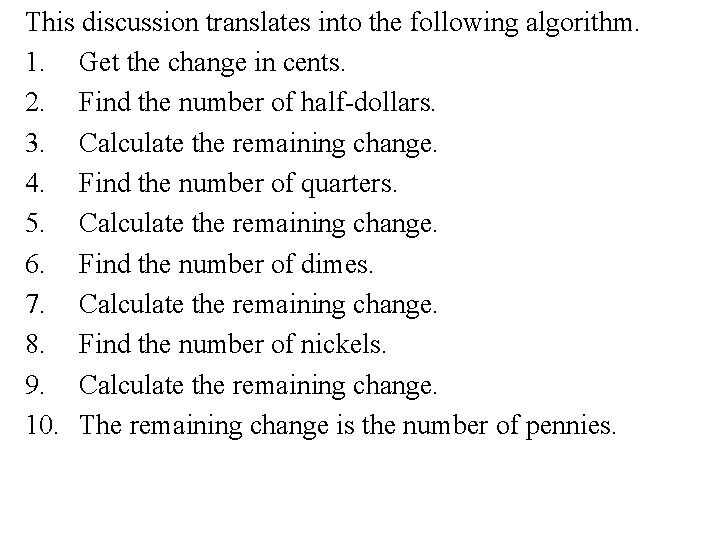
This discussion translates into the following algorithm. 1. Get the change in cents. 2. Find the number of half-dollars. 3. Calculate the remaining change. 4. Find the number of quarters. 5. Calculate the remaining change. 6. Find the number of dimes. 7. Calculate the remaining change. 8. Find the number of nickels. 9. Calculate the remaining change. 10. The remaining change is the number of pennies.
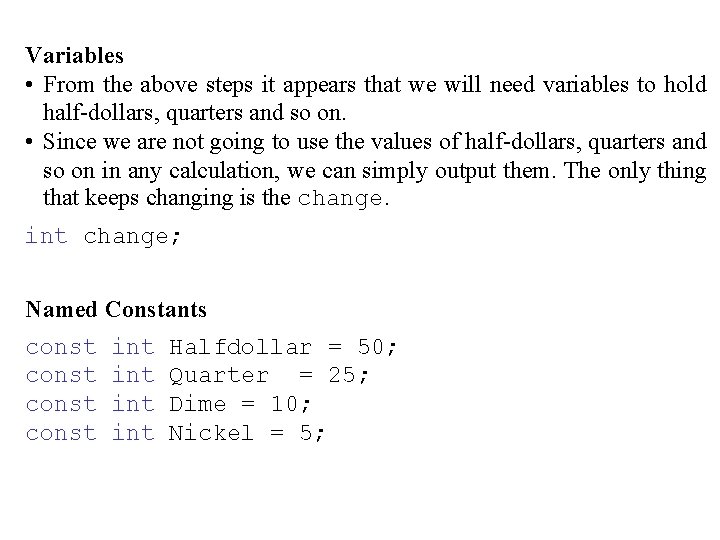
Variables • From the above steps it appears that we will need variables to hold half-dollars, quarters and so on. • Since we are not going to use the values of half-dollars, quarters and so on in any calculation, we can simply output them. The only thing that keeps changing is the change. int change; Named Constants const int int Halfdollar = 50; Quarter = 25; Dime = 10; Nickel = 5;
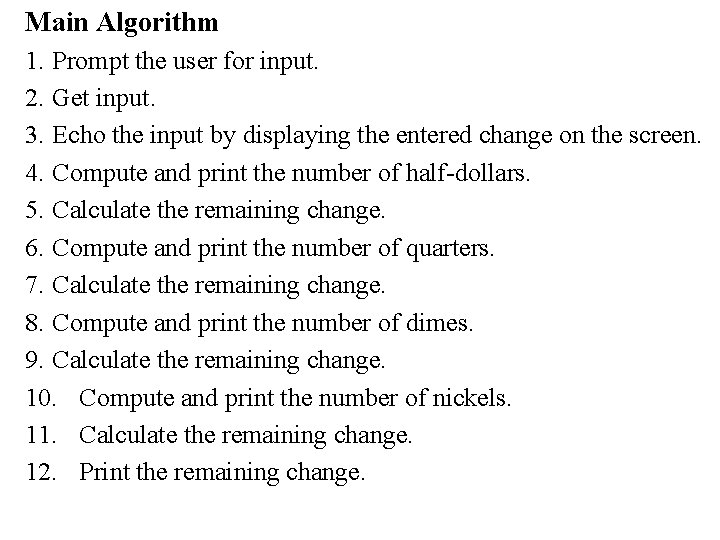
Main Algorithm 1. Prompt the user for input. 2. Get input. 3. Echo the input by displaying the entered change on the screen. 4. Compute and print the number of half-dollars. 5. Calculate the remaining change. 6. Compute and print the number of quarters. 7. Calculate the remaining change. 8. Compute and print the number of dimes. 9. Calculate the remaining change. 10. Compute and print the number of nickels. 11. Calculate the remaining change. 12. Print the remaining change.
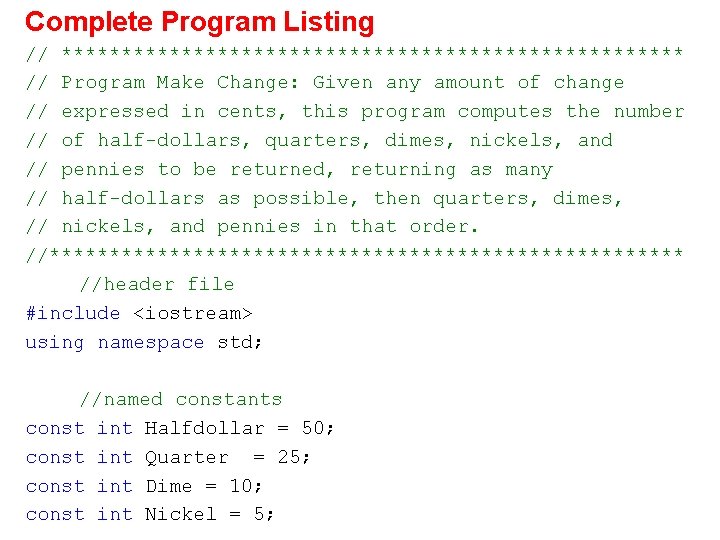
Complete Program Listing // ************************** // Program Make Change: Given any amount of change // expressed in cents, this program computes the number // of half-dollars, quarters, dimes, nickels, and // pennies to be returned, returning as many // half-dollars as possible, then quarters, dimes, // nickels, and pennies in that order. //*************************** //header file #include <iostream> using namespace std; //named constants const int Halfdollar = 50; const int Quarter = 25; const int Dime = 10; const int Nickel = 5;
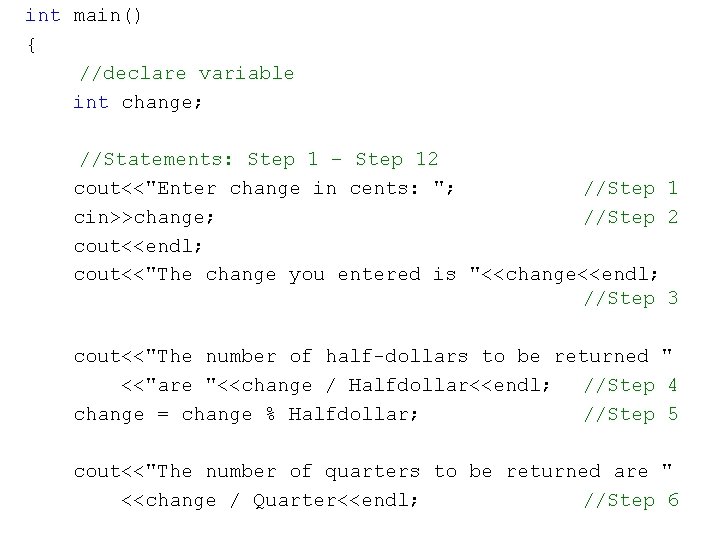
int main() { //declare variable int change; //Statements: Step 1 – Step 12 cout<<"Enter change in cents: "; //Step 1 cin>>change; //Step 2 cout<<endl; cout<<"The change you entered is "<<change<<endl; //Step 3 cout<<"The number of half-dollars to be returned " <<"are "<<change / Halfdollar<<endl; //Step 4 change = change % Halfdollar; //Step 5 cout<<"The number of quarters to be returned are " <<change / Quarter<<endl; //Step 6
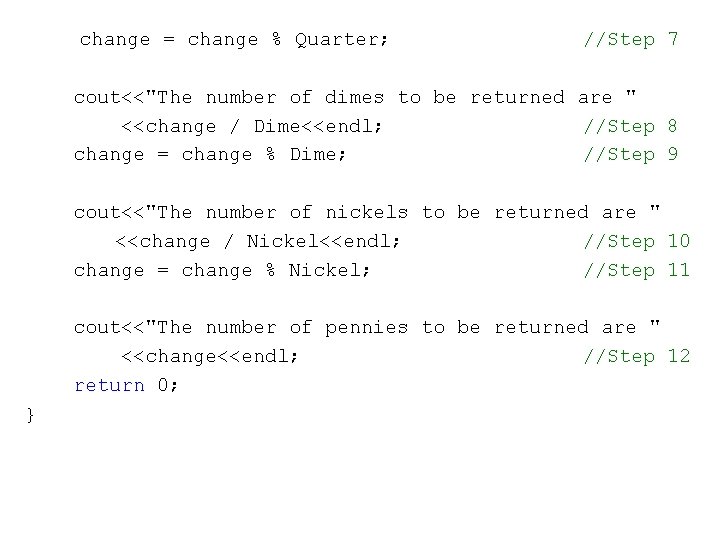
change = change % Quarter; //Step 7 cout<<"The number of dimes to be returned are " <<change / Dime<<endl; //Step 8 change = change % Dime; //Step 9 cout<<"The number of nickels to be returned are " <<change / Nickel<<endl; //Step 10 change = change % Nickel; //Step 11 cout<<"The number of pennies to be returned are " <<change<<endl; //Step 12 return 0; }
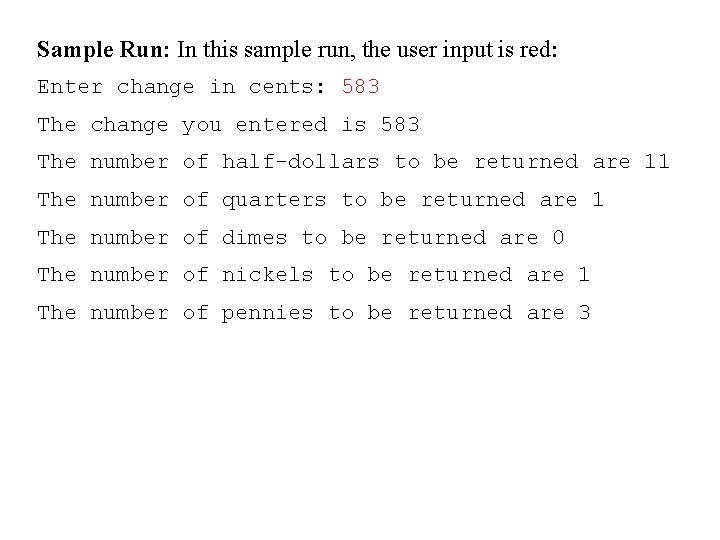
Sample Run: In this sample run, the user input is red: Enter change in cents: 583 The change you entered is 583 The number of half-dollars to be returned are 11 The number of quarters to be returned are 1 The number of dimes to be returned are 0 The number of nickels to be returned are 1 The number of pennies to be returned are 3
- Slides: 136